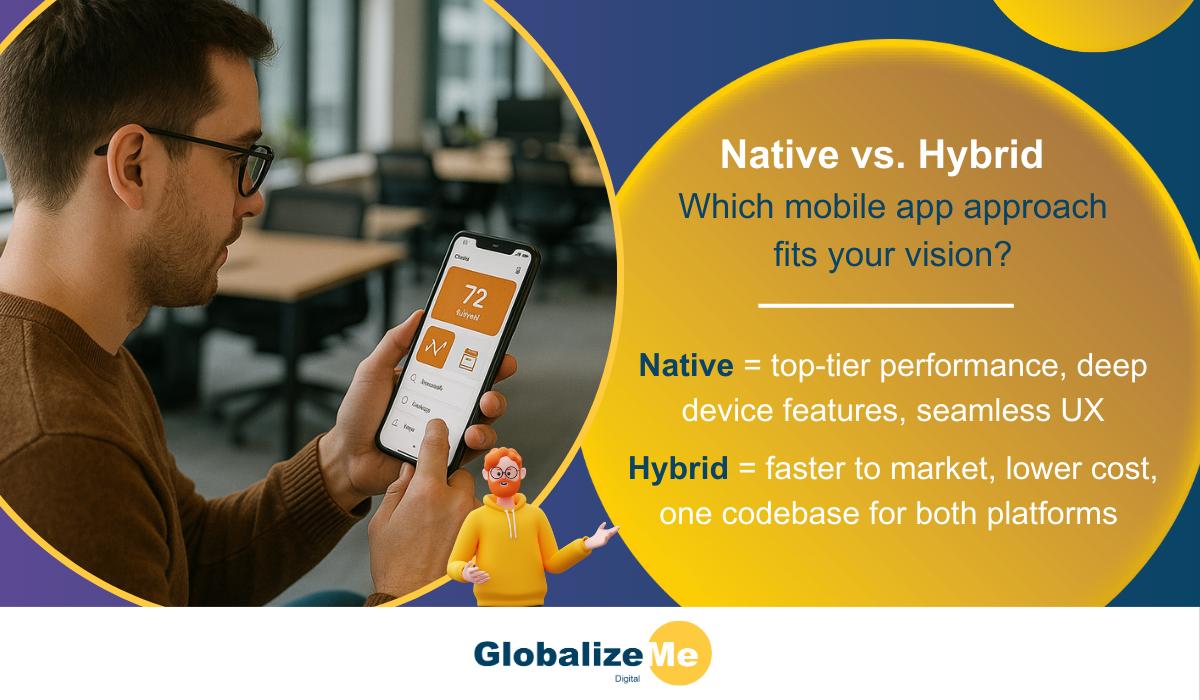Native vs. Hybrid: How to Choose the Right Mobile App Framework

If you’re thinking about building a mobile app, chances are you’ve already come across the big question: Should we go native or hybrid?
It’s a classic dilemma and like most good tech questions, the answer is: it depends.
At GlobalizeMe, we’ve been around the block a few times when it comes to app development. We’ve worked with native tech stacks (Swift and Kotlin) as well as “wrapped” frameworks like React Native and Ionic. We’ve seen the strengths, the challenges, and the “I wish someone told me this earlier” moments.
Let’s take a closer look at the options and explore what might make the most sense for your project.
So, what’s the difference?
Native apps are built specifically for iOS or Android using the official tools and languages. That means top performance, deep device integration, and a UI that feels completely at home on your phone.
Hybrid or wrapped apps (like those built with React Native or Ionic) are written once and work on both platforms. They’re built using web tech (like JavaScript or TypeScript) and then “wrapped” to behave like a native app.
Think of it like this:
- Native is like designing a bespoke suit for each platform.
- Hybrid is more like getting a really good tailored suit that fits both parties well enough to impress.
Which one should you choose?
This is the million-dollar question, and the answer really comes down to what you’re building, who’s building it, and what your priorities are.
Let’s say performance is absolutely critical. Maybe you’re working on a mobile game, a fitness app with real-time tracking, or something packed with complex animations. In that case, native development is your best bet. Native apps are built to squeeze every drop of performance out of a device, and that really matters when you’re pushing the limits.
But if your app is more about information, interaction, or standard business workflows (think dashboards, booking systems, customer portals) a hybrid approach like React Native or Ionic is often more than enough. You’ll save time, you’ll save budget, and you can still create a great experience for your users.
Another big factor is your team. If you’ve got a strong in-house web development crew, they can often pivot into a hybrid framework pretty smoothly. React Native, in particular, plays really nicely with existing web skills. Native development, on the other hand, usually needs a separate team for iOS and Android, so you’ll need either more developers or more budget.
And finally, there’s the user experience. Native apps tend to feel slightly more fluid and “at home” on each device. That said, with careful design and the right framework, hybrid apps can get very close and, in many cases, users won’t notice the difference.
Here’s how we usually see it play out:
In our experience, clients building a first version of their app (especially startups or innovation teams) tend to go hybrid. It’s faster, more cost-effective, and you get something in people’s hands sooner, which is great for testing and feedback.
If a client is building something very specific to a platform, or their app relies heavily on the phone’s native features (like camera control, GPS tracking, or Bluetooth integration) we’ll lean toward a native build. The same goes for apps that need to run buttery-smooth animations or handle a lot of background processing.
Then there are projects where time-to-market is the top priority. Maybe the app needs to launch on both platforms at once, or it’s tied to a bigger product rollout. In those cases, we’ll usually recommend a hybrid approach to speed things up without sacrificing too much on quality.
It’s never a one-size-fits-all situation. The key is knowing what matters most for your app right now – speed, performance, scalability, team fit – and making the framework decision based on that.
Don’t forget about support…
One thing that’s often overlooked is what happens after launch.
- Native apps can be a bit trickier to support, especially if your team doesn’t already have native dev experience.
- With hybrid apps, your existing web devs can often handle support and maintenance with minimal ramp-up.
At GlobalizeMe, we support both native and hybrid app workflows for clients around the world, from financial services to sports and pharma. And because everything we build is hosted on our secure global AWS stacks, we’ve got monitoring, performance, and updates covered too.
Final thoughts from the team
Honestly, the choice between native and hybrid isn’t about what’s better, it’s about what’s better for you.
If you’re building an MVP, want to get to market fast, or already have a strong web development team – hybrid could be perfect.
If you’re building something that needs to push the limits of mobile performance or use cutting-edge device features – native might be worth the investment.
And if you’re still not sure which route is right? That’s what we’re here for.
Let’s talk it through
If you’re planning a mobile app and want some straight-up, no-nonsense advice from a team who’s done this across sectors and continents, let’s chat.
We’ll help you figure out what fits your goals, your budget, and your team. Whether that’s a native build, a React Native hybrid, or something in between.
Drop us a line at GlobalizeMe. We would love to help.
